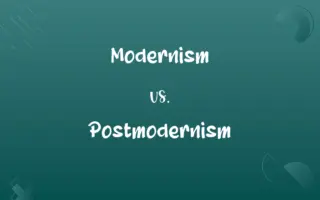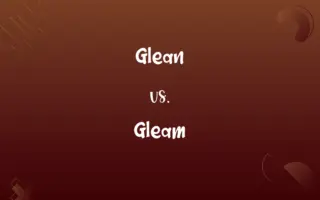Welding vs. Soldering: Know the Difference

By Shumaila Saeed || Published on January 4, 2024
Welding fuses materials by melting them together, while soldering involves joining items using a filler metal.

Key Differences
Welding is a process of joining two materials, typically metals, by melting them together at high temperatures. Soldering, in contrast, uses a lower temperature to melt a filler metal, called solder, which joins the pieces without melting the base materials.
Shumaila Saeed
Jan 04, 2024
In welding, the materials being joined usually become homogeneously fused, often requiring high skill and specialized equipment. Soldering, on the other hand, is generally less intensive, involving a soldering iron to melt the solder that adheres to the surfaces being joined.
Shumaila Saeed
Jan 04, 2024
Welding is often used in heavy-duty applications like construction and manufacturing due to its strength. Soldering is more common in electronics and plumbing, where delicate connections are necessary.
Shumaila Saeed
Jan 04, 2024
The strength of a welded joint is typically much higher than that of a soldered joint. Soldering is advantageous for its precision and the ability to be used on heat-sensitive components.
Shumaila Saeed
Jan 04, 2024
Welding requires protective gear for safety, including masks and gloves, due to its intense heat and light. Soldering, while also needing caution, generally involves less intense conditions, making it more accessible for smaller projects and hobbyists.
Shumaila Saeed
Jan 04, 2024
ADVERTISEMENT
Comparison Chart
Temperature
High temperatures, melting the base materials
Lower temperatures, melting only the filler metal
Shumaila Saeed
Jan 04, 2024
Equipment
Requires heavy-duty equipment and protective gear
Uses a soldering iron or gun
Shumaila Saeed
Jan 04, 2024
Application
Ideal for construction, manufacturing
Suited for electronics, plumbing
Shumaila Saeed
Jan 04, 2024
Joint Strength
Creates strong, homogeneous joints
Produces less strong joints
Shumaila Saeed
Jan 04, 2024
Skill Requirement
Requires high skill and training
Easier to learn, more accessible
Shumaila Saeed
Jan 04, 2024
ADVERTISEMENT
Welding and Soldering Definitions
Welding
A fabrication method where two materials are fused together using heat and pressure.
The sculpture was created by welding copper and iron pieces together.
Shumaila Saeed
Dec 18, 2023
Soldering
A method of bonding materials using a metal alloy with a lower melting point than the workpieces.
Soldering copper pipes is a common plumbing task.
Shumaila Saeed
Dec 18, 2023
Welding
The act of coalescing materials using a combination of heat and pressure.
Welding aluminum requires precise temperature control.
Shumaila Saeed
Dec 18, 2023
Soldering
The technique of melting a low-temperature alloy to create a joint between two components.
He used soldering to repair the broken wire in the gadget.
Shumaila Saeed
Dec 18, 2023
Welding
The process of joining metals by heating them to a melting point.
They used welding to repair the broken steel frame.
Shumaila Saeed
Dec 18, 2023
ADVERTISEMENT
Soldering
The act of joining metals by melting a filler metal, called solder, into the joint.
She demonstrated soldering skills while fixing the jewelry.
Shumaila Saeed
Dec 18, 2023
Welding
A technique to bond materials, usually metals or thermoplastics, by coalescence.
His expertise in welding was evident in the seamless joints of the metalwork.
Shumaila Saeed
Dec 18, 2023
Soldering
A process of joining two pieces using a melted filler metal.
Soldering is essential for assembling electronic circuit boards.
Shumaila Saeed
Dec 18, 2023
Welding
The process of uniting surfaces by softening them with heat and applying pressure.
They taught welding basics in the vocational training program.
Shumaila Saeed
Dec 18, 2023
Soldering
The process of using a filler metal to connect pieces at lower temperatures than welding.
Precise soldering was required to ensure the integrity of the electronic components.
Shumaila Saeed
Dec 18, 2023
Welding
To join (metals) by applying heat, sometimes with pressure and sometimes with an intermediate or filler metal having a high melting point.
Shumaila Saeed
Dec 13, 2023
Soldering
Any of various fusible alloys, usually tin and lead, used to join metallic parts.
Shumaila Saeed
Dec 13, 2023
Soldering
To join or unite
The agreement soldered the factions into an alliance.
Shumaila Saeed
Dec 13, 2023
Welding
Joining two materials (especially two metals) together by applying heat, pressure and filler, either separately or in any combination, or
Shumaila Saeed
Dec 13, 2023
Soldering
A method of joining two metallic surfaces by melting an alloy between them.
Shumaila Saeed
Dec 13, 2023
Welding
Fastening two pieces of metal together by softening with heat and applying pressure
Shumaila Saeed
Dec 13, 2023
Repeatedly Asked Queries
How hot does welding get?
Welding temperatures can exceed 6,500°F (3,593°C), depending on the method and materials.
Shumaila Saeed
Jan 04, 2024
What temperature is used in soldering?
Soldering typically occurs at temperatures around 400°F to 842°F (204°C to 450°C).
Shumaila Saeed
Jan 04, 2024
What is welding?
Welding is a fabrication process that joins materials, typically metals, by melting them together.
Shumaila Saeed
Jan 04, 2024
Is soldering suitable for joining different metals?
Soldering can join different metals, but the strength and compatibility depend on the solder and flux used.
Shumaila Saeed
Jan 04, 2024
Can welding be used for delicate electronics?
Welding is generally not suitable for delicate electronics due to the high temperatures involved.
Shumaila Saeed
Jan 04, 2024
What is soldering?
Soldering is a method of joining two items using a filler metal with a lower melting point than the pieces being joined.
Shumaila Saeed
Jan 04, 2024
What materials can be welded?
Most metals and some thermoplastics can be welded using appropriate techniques.
Shumaila Saeed
Jan 04, 2024
Can welding join dissimilar metals?
Yes, welding can join dissimilar metals, but it requires specific techniques and filler materials.
Shumaila Saeed
Jan 04, 2024
What materials are commonly soldered?
Commonly soldered materials include copper, brass, silver, and electronic components.
Shumaila Saeed
Jan 04, 2024
What is a welding rod?
A welding rod is a piece of filler metal used in certain welding processes to create the weld.
Shumaila Saeed
Jan 04, 2024
Can soldered joints be undone?
Soldered joints can be undone by reheating the solder and separating the components.
Shumaila Saeed
Jan 04, 2024
What safety precautions are necessary for soldering?
For soldering, use safety glasses, a fume extractor, and avoid touching the hot soldering iron tip.
Shumaila Saeed
Jan 04, 2024
Is soldering used in automotive repair?
Soldering is used in automotive repair, particularly in electrical system repairs.
Shumaila Saeed
Jan 04, 2024
What safety equipment is needed for welding?
Welding requires protective gear like a welding helmet, gloves, and protective clothing.
Shumaila Saeed
Jan 04, 2024
What is arc welding?
Arc welding is a welding process that uses an electric arc to generate heat for melting the metal.
Shumaila Saeed
Jan 04, 2024
How does welding strength compare to soldering?
Welded joints are generally stronger and more durable than soldered joints.
Shumaila Saeed
Jan 04, 2024
Do welding and soldering require training?
Both welding and soldering require training, but welding typically demands more extensive skills and practice.
Shumaila Saeed
Jan 04, 2024
What is solder made of?
Solder is usually made of a tin-lead alloy, or lead-free alternatives like tin-copper or tin-silver.
Shumaila Saeed
Jan 04, 2024
Can welded joints be disassembled?
Welded joints are permanent and typically cannot be disassembled without cutting.
Shumaila Saeed
Jan 04, 2024
What is flux in soldering?
Flux is a chemical cleaning agent used in soldering to remove oxides and prevent re-oxidation.
Shumaila Saeed
Jan 04, 2024
Share this page
Link for your blog / website
HTML
Link to share via messenger
About Author
Written by
Shumaila SaeedShumaila Saeed, an expert content creator with 6 years of experience, specializes in distilling complex topics into easily digestible comparisons, shining a light on the nuances that both inform and educate readers with clarity and accuracy.






































































